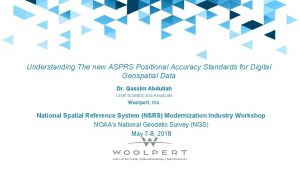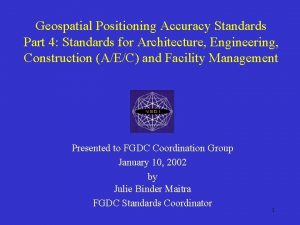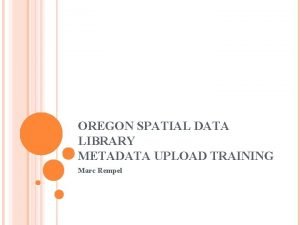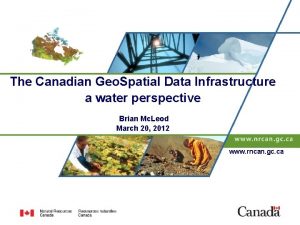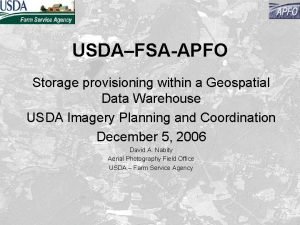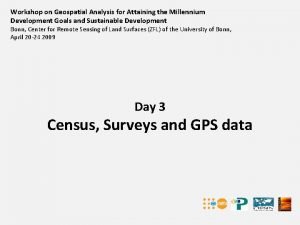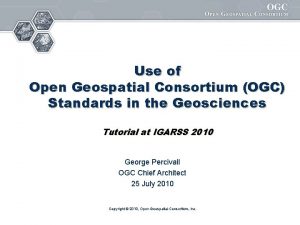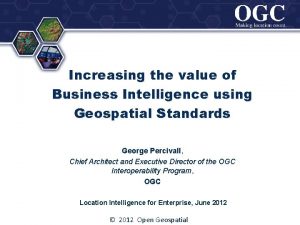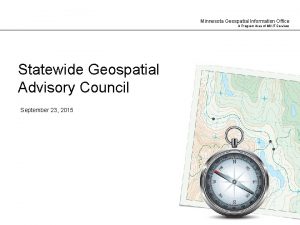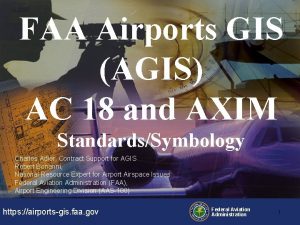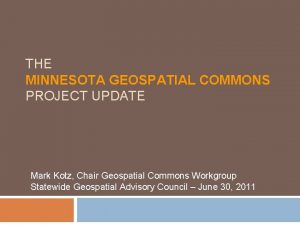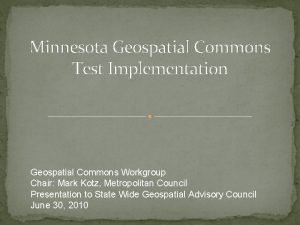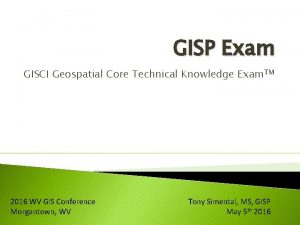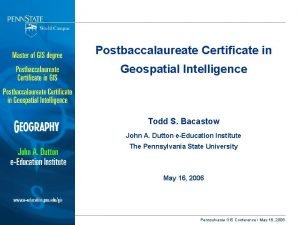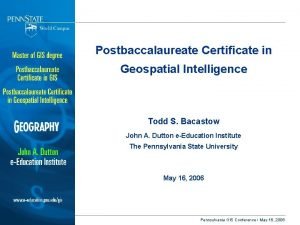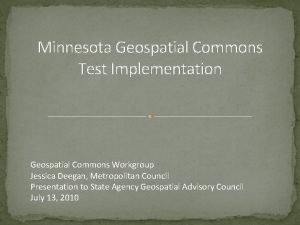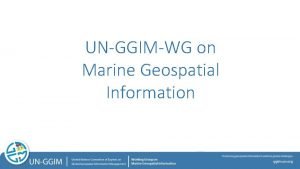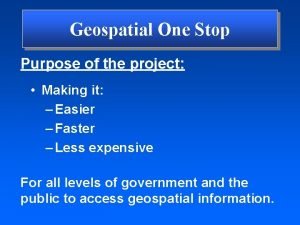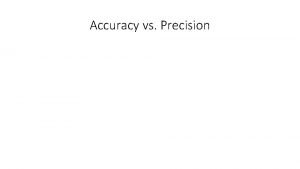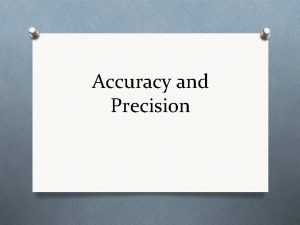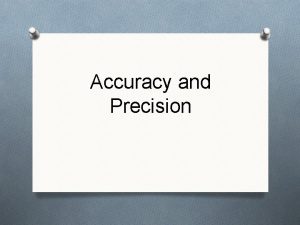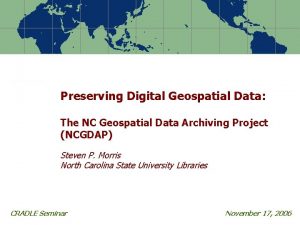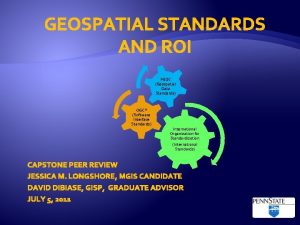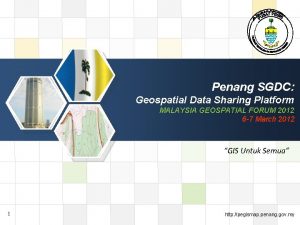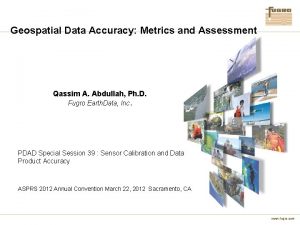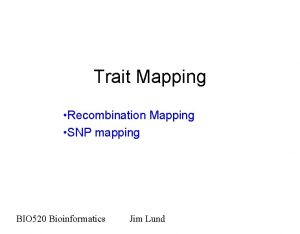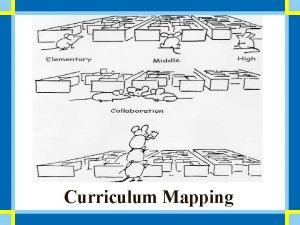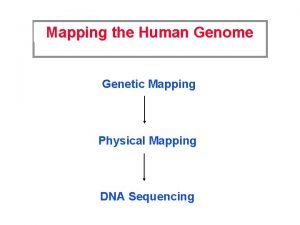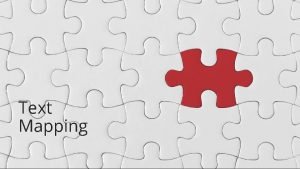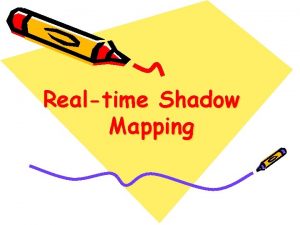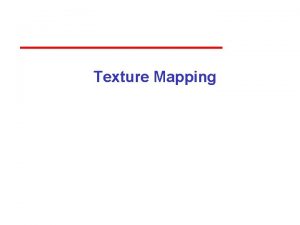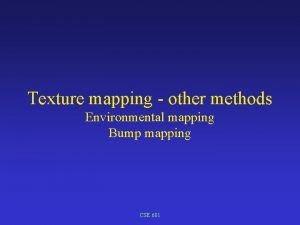Geospatial Data Accuracy and the New Mapping Accuracy











![Common Horizontal Accuracy Classes according to the new standard[1] Horizontal Accuracy Class RMSEx and Common Horizontal Accuracy Classes according to the new standard[1] Horizontal Accuracy Class RMSEx and](https://slidetodoc.com/presentation_image_h/136c4b9317f0f1759bc82ab5cbee6677/image-12.jpg)




















- Slides: 32

Geospatial Data Accuracy and the New Mapping Accuracy Standard: New Era Session #35 Dr. Qassim Abdullah, Woolpert, Inc. Pierre Le Roux, Aerometric, Inc. Becky Morton, Towill, Inc. 1

New ASPRS Positional Accuracy Standards for Digital Geospatial Data Drafting Committee: Chair: Douglas L. Smith, David C. Smith & Associates, Inc. Dr. Qassim A. Abdullah, Woolpert, Inc. Dr. David Maune, Dewberry Karl Hans Heidemann, USGS REVISION 7, VERSION 1 NOVEMBER 14, 2014 (FINAL BOARD APPROVAED Version) 2

New ASPRS Positional Accuracy Standards for Digital Geospatial Data Ø Replaces: • ASPRS Accuracy Standards for Large-Scale Maps (1990) • ASPRS Guidelines, Vertical Accuracy Reporting for Lidar Data (2004) Ø Developed by: ASPRS Map Accuracy Standards Working Group, PAD, PDAD and LIDAR joint committee for map accuracy standard update Ø In Final Approved Version • REVISION 7, VERSION 1, Nov. 14, 2014 • Approved and adopted by ASPRS during the board meeting on Monday Nov. 17, 2014 in Denver during ASPRS 2014 PECORA conference 3

New Standard for a New Era Motivation Behind the New Standard: • Legacy map accuracy standards, such as the ASPRS 1990 standard and the NMAS of 1947, are outdated. (over 30 years since ASPRS 1990 was written) • Many of the data acquisition and mapping technologies that these standards were based on are no longer used. • More recent advances in mapping technologies can now produce better quality and higher accuracy geospatial products and maps. • Legacy map accuracy standards were designed to deal with plotted or drawn maps as the only medium to represent geospatial data. 4

New Standard for a New Era • Within the past two decades (during the transition period between the hardcopy and softcopy mapping environments), most standard measures for relating GSD and map scale to the final mapping accuracy were inherited from photogrammetric practices using scanned film. • New mapping processes and methodologies have become much more sophisticated with advances in technology and advances in our knowledge of mapping processes and mathematical modeling. • Mapping accuracy can no longer be associated with the camera geometry and flying altitude alone (focal length, xp, yp, B/H ratio, etc. ). 5

New Standard for a New Era • New map accuracy is influenced by many factors such as: – the quality of camera calibration parameters; – quality and size of a Charged Coupled Device (CCD) used in the digital camera CCD array; – amount of imagery overlap; – quality of parallax determination or photo measurements; – quality of the GPS signal; – quality and density of ground controls; – quality of the aerial triangulation solution; – capability of the processing software to handle GPS drift and shift; – capability of the processing software to handle camera selfcalibration, – the digital terrain model used for the production of orthoimagery. 6 • .

New Standard for a New Era • These factors can vary widely from project to project, depending on the sensor used and specific methodology. For these reasons, existing accuracy measures based on map scale, film scale, GSD, c-factor and scanning resolution no longer apply to current geospatial mapping practices. • Elevation products from the new technologies and active sensors such as lidar and IFSAR are not considered by the legacy mapping standards. New accuracy standards are needed to address elevation products derived from these technologies. 7

ASPRS Positional Accuracy Standards for Digital Geospatial Data – Applicability: • Defines specific accuracy classes and associated RMSE thresholds for digital orthoimagery, digital planimetric data, and digital elevation data • Intended to be technology independent • Limited to accuracy thresholds and testing methodologies for any mapping applications, and to meet immediate shortcomings in the outdated 1990 and 2004 standards • Is not intended to cover classification accuracy of thematic maps • Does not specify the best practices or methodologies needed to meet the accuracy thresholds – Includes: • Glossary, Symbols, examples, conversion to legacy standards 8

New Standard Highlights – Positional Accuracy Thresholds which are independent of published GSD, map scale or contour interval • digital orthoimagery • digital elevation data – Additional Accuracy Measures • aerial triangulation accuracy, • Ground controls accuracy, • orthoimagery seam lines accuracy, • lidar relative swath-to-swath accuracy, • recommended minimum Nominal Pulse Density (NPD) • horizontal accuracy of elevation data, • delineation of low confidence areas for vertical data • required number and spatial distribution of QA/QC check points based on project area 9

New Standard Highlights – Positional Accuracy Thresholds which are independent of published GSD, map scale or contour interval • digital orthoimagery • digital elevation data – Additional Accuracy Measures • aerial triangulation accuracy, • Ground controls accuracy, • orthoimagery seam lines accuracy, • lidar relative swath-to-swath accuracy, • recommended minimum Nominal Pulse Density (NPD) • horizontal accuracy of elevation data, • delineation of low confidence areas for vertical data • required number and spatial distribution of QA/QC check points based on project area 10

New Standard Highlights – It is All Metric! – Unlimited Horizontal Accuracy Classes: Horizontal Accuracy Standards for Geospatial Data Horizontal Accuracy Class RMSEx and RMSEy (cm) X-cm ≤X RMSEr (cm) Horizontal Accuracy at 95% Confidence Level (cm) Orthoimagery Mosaic Seamline Mismatch (cm) ≤ 1. 41*X ≤ 2. 45*X ≤ 2*X 11
![Common Horizontal Accuracy Classes according to the new standard1 Horizontal Accuracy Class RMSEx and Common Horizontal Accuracy Classes according to the new standard[1] Horizontal Accuracy Class RMSEx and](https://slidetodoc.com/presentation_image_h/136c4b9317f0f1759bc82ab5cbee6677/image-12.jpg)
Common Horizontal Accuracy Classes according to the new standard[1] Horizontal Accuracy Class RMSEx and RMSEy (cm) RMSEr (cm) Orthoimage Mosaic Seamline Maximum Mismatch (cm) Horizontal Accuracy at the 95% Confidence Level (cm) 0. 63 0. 9 1. 3 1. 5 1. 25 1. 8 2. 5 3. 1 2. 50 3. 5 5. 0 6. 1 5. 00 7. 1 10. 0 12. 2 7. 50 10. 6 15. 0 18. 4 10. 00 14. 1 20. 0 24. 5 12. 50 17. 7 25. 0 30. 6 15. 00 21. 2 30. 0 36. 7 17. 50 24. 7 35. 0 42. 8 20. 00 28. 3 40. 0 49. 0 22. 50 31. 8 45. 0 55. 1 25. 00 35. 4 50. 0 61. 2 27. 50 38. 9 55. 0 67. 3 30. 00 42. 4 60. 0 73. 4 45. 00 63. 6 90. 0 110. 1 60. 00 84. 9 120. 0 146. 9 75. 00 106. 1 150. 0 183. 6 100. 00 141. 4 200. 0 244. 8 150. 00 212. 1 300. 0 367. 2 200. 00 282. 8 400. 0 489. 5 250. 00 353. 6 500. 0 611. 9 300. 00 424. 3 600. 0 734. 3 500. 00 707. 1 1000. 0 1223. 9 1000. 00 1414. 2 2000. 0 2447. 7 12

Common Orthoimager y Pixel Sizes Examples on Horizontal Accuracy for Digital Orthoimagery interpreted from ASPRS 1990 Legacy Standard. 0. 625 cm 1. 25 cm 2. 5 cm 7. 5 cm 15 cm Associated Map Scale 1: 50 1: 100 1: 200 1: 400 1: 600 1: 1, 200 ASPRS 1990 Accuracy Class Associated Horizontal Accuracy According to Legacy ASPRS 1990 Standard RMSEx and RMSEy (cm) RMSEx and RMSEy in terms of pixels 1 1. 3 2 -pixels 2 2. 5 4 -pixels 3 3. 8 6 -pixels 1 2. 5 2 -pixels 2 5. 0 4 -pixels 3 7. 5 6 -pixels 1 5. 0 2 -pixels 2 10. 0 4 -pixels 3 15. 0 6 -pixels 1 10. 0 2 -pixels 2 20. 0 4 -pixels 3 30. 0 6 -pixels 1 15. 0 2 -pixels 2 30. 0 4 -pixels 3 45. 0 6 -pixels 1 30. 0 2 -pixels 2 60. 0 4 -pixels 3 90. 0 6 -pixels 13

Common Orthoimage ry Pixel Sizes 1. 25 cm Digital Orthoimagery Accuracy Examples for Current Large and Medium Format Metric Cameras 2. 5 cm 7. 5 cm 15 cm Recommended Horizontal Accuracy Class Orthoimage RMSEx and RMSEy in terms of RMSEy (cm) pixels Recommended use ≤ 1. 3 ≤ 1 -pixel Highest accuracy work 2. 5 2 -pixels Standard Mapping and GIS work ≥ 3. 8 ≥ 3 -pixels Visualization and less accurate work ≤ 2. 5 ≤ 1 -pixel Highest accuracy work 5. 0 2 -pixels Standard Mapping and GIS work ≥ 7. 5 ≥ 3 -pixels Visualization and less accurate work ≤ 5. 0 ≤ 1 -pixel Highest accuracy work 10. 0 2 -pixels Standard Mapping and GIS work ≥ 15. 0 ≥ 3 -pixels Visualization and less accurate work ≤ 7. 5 ≤ 1 -pixel Highest accuracy work 15. 0 2 -pixels Standard Mapping and GIS work ≥ 22. 5 ≥ 3 -pixels Visualization and less accurate work ≤ 15. 0 ≤ 1 -pixel Highest accuracy work 30. 0 2 -pixels Standard Mapping and GIS work ≥ 45. 0 ≥ 3 -pixels Visualization and less 14 accurate work

Horizontal Accuracy/Quality Examples for High Accuracy Digital Planimetric Data Equivalent to map scale in ASPRS 2014 Horizontal Accuracy Class RMSEx and RMSEy (cm) Equivalent to map scale in NMAS RMSEr (cm) Horizontal Accuracy at the 95% Confidence Level (cm) Approximate GSD of Source Imagery (cm) ASPRS 1990 Class 1 ASPRS 1990 Class 2 0. 63 0. 9 1. 5 0. 31 to 0. 63 1: 25 1: 12. 5 1: 16 1. 25 2. 5 5. 0 7. 5 10. 0 12. 5 15. 0 17. 5 20. 0 22. 5 25. 0 27. 5 30. 0 1. 8 3. 5 7. 1 10. 6 14. 1 17. 7 21. 2 24. 7 28. 3 31. 8 35. 4 38. 9 42. 4 3. 1 6. 1 12. 2 18. 4 24. 5 30. 6 36. 7 42. 8 49. 0 55. 1 61. 2 67. 3 73. 4 0. 63 to 1. 25 to 2. 5 to 5. 0 3. 8 to 7. 5 5. 0 to 10. 0 6. 3 to 12. 5 7. 5 to 15. 0 8. 8 to 17. 5 10. 0 to 20. 0 11. 3 to 22. 5 12. 5 to 25. 0 13. 8 to 27. 5 15. 0 to 30. 0 1: 50 1: 100 1: 200 1: 300 1: 400 1: 500 1: 600 1: 700 1: 800 1: 900 1: 1000 1: 1100 1: 1200 1: 25 1: 50 1: 100 1: 150 1: 200 1: 250 1: 300 1: 350 1: 400 1: 450 1: 500 1: 550 1: 600 1: 32 1: 63 1: 127 1: 190 1: 253 1: 317 1: 380 1: 444 1: 507 1: 570 1: 634 1: 697 1: 760 15

New Standard Highlights – Unlimited Vertical Accuracy Classes: Vertical Accuracy Standards for Digital Elevation Data Absolute Accuracy Relative Accuracy (where applicable) Vertical Accuracy Class RMSEz Non. Vegetated (cm) NVA at 95% Confidence Level (cm) VVA at 95 th Percentile (cm) Within- Swath Hard Surface Repeatability (Max Diff) (cm) X-cm ≤X ≤ 1. 96*X ≤ 3. 00*X ≤ 0. 60*X Swath-to. Swath Non-Vegetated Terrain (RMSDz) (Max Diff) (cm) ≤ 0. 80*X ≤ 1. 60*X 16

Vertical Accuracy/Quality Examples for Digital Elevation Data Absolute Accuracy Relative Accuracy (where applicable) Vertical Accuracy Class RMSEz Non. Vegetated (cm) NVA at 95% Confidence Level (cm) at 95 th Percentile 1 -cm 1. 0 2. 5 -cm 2. 5 5 -cm Within-Swath Hard Surface Repeatability (Max Diff) (cm) Swath-to-Swath Non-Veg Terrain (RMSDz) (cm) Swath-to-Swath Non-Veg Terrain (Max Diff) (cm) 3 0. 6 0. 8 1. 6 4. 9 7. 5 1. 5 2 4 5. 0 9. 8 15 3 4 8 10 -cm 10. 0 19. 6 30 6 8 16 15 -cm 15. 0 29. 4 45 9 12 24 20 -cm 20. 0 39. 2 60 12 16 32 33. 3 -cm 33. 3 65. 3 100 20 26. 7 53. 3 66. 7 -cm 66. 7 130. 7 200 40 53. 3 106. 7 100 -cm 100. 0 196. 0 300 60 80 160 333. 3 -cm 333. 3 653. 3 1000 266. 7 533. 3 VVA (cm) 17

Vertical accuracy of the new ASPRS 2014 standard compared with legacy standards Vertical Accuracy Class RMSEz Non-Vegetated (cm) 1 -cm 1. 0 3. 0 1. 5 3. 29 2. 5 -cm 2. 5 7. 5 3. 8 8. 22 5 -cm 5. 0 15. 0 7. 5 16. 45 10 -cm 10. 0 30. 0 15. 0 32. 90 15 -cm 15. 0 45. 0 22. 5 49. 35 20 -cm 20. 0 60. 0 30. 0 65. 80 33. 3 -cm 33. 3 99. 9 50. 0 109. 55 66. 7 -cm 66. 7 200. 1 100. 1 219. 43 100 -cm 100. 0 300. 0 150. 0 328. 98 333. 3 -cm 333. 3 999. 9 500. 0 1096. 49 Equivalent Class 1 contour Equivalent Class 2 contour interval per ASPRS 1990 (cm) Equivalent contour interval per NMAS (cm) 18

Examples on Vertical Accuracy and Recommended Lidar Point Density for Digital Elevation Data according to the new ASPRS 2014 standard Absolute Accuracy Vertical Accuracy Class RMSEz Non-Vegetated (cm) NVA at 95% Confidence Level (cm) 1 -cm 1. 0 2. 5 -cm Recommended Minimum NPD (pts/m 2) Recommended Maximum NPS 7 (m) 2. 0 ≥ 20 ≤ 0. 22 2. 5 4. 9 16 0. 25 5 -cm 5. 0 9. 8 8 0. 35 10 -cm 10. 0 19. 6 2 0. 71 15 -cm 15. 0 29. 4 1 1. 0 20 -cm 20. 0 39. 2 0. 5 1. 4 33. 3 -cm 33. 3 65. 3 0. 25 2. 0 66. 7 -cm 66. 7 130. 7 0. 1 3. 2 100 -cm 100. 0 196. 0 0. 05 4. 5 333. 3 -cm 333. 3 653. 3 0. 01 10. 0 19

Horizontal accuracy requirements for elevation data • 20

Expected horizontal errors (RMSEr) for Lidar data in terms of flying altitude Altitude (m) Positional RMSEr (cm) 500 13. 1 3, 000 41. 6 1, 000 17. 5 3, 500 48. 0 1, 500 23. 0 4, 000 54. 5 2, 000 29. 0 4, 500 61. 1 2, 500 35. 2 5, 000 67. 6 21

Low Confidence Areas in Lidar Dataset Vertical Accuracy Class Recommended Project Min NPD (pts/m 2) (Max NPS (m)) Recommended Low Confidence Min NGPD (pts/m 2) (Max NGPS (m)) Search Radius and Low Confidence Cell Size Polygons for Computing NGPD Min Area (m) (acres (m 2)) 1 -cm ≥ 20 (≤ 0. 22) ≥ 5 (≤ 0. 45) 0. 67 0. 5 (2, 000) 2. 5 -cm 16 (0. 25) 4 (0. 50) 0. 75 1 (4, 000) 5 -cm 8 (0. 35) 2 (0. 71) 1. 06 2 (8, 000) 10 -cm 2 (0. 71) 0. 5 (1. 41) 2. 12 5 (20, 000) 15 -cm 1 (1. 0) 0. 25 (2. 0) 3. 00 5 (20, 000) 20 -cm 0. 5 (1. 4) 0. 125 (2. 8) 4. 24 5 (20, 000) 33. 3 -cm 0. 25 (2. 0) 0. 0625 (4. 0) 6. 0 10 (40, 000) 66. 7 -cm 0. 1 (3. 2) 0. 025 (6. 3) 9. 5 15 (60, 000) 100 -cm 0. 05 (4. 5) 0. 0125 (8. 9) 13. 4 20 (80, 000) 333. 3 -cm 0. 01 (10. 0) 0. 0025 (20. 0) 30. 0 25 (100, 000) 22

Accuracy requirements for aerial triangulation and INS-based sensor orientation of digital imagery • Accuracy of aerial triangulation designed for digital planimetric data (orthoimagery and/or digital planimetric map) only: RMSEx(AT) or RMSEy(AT) = ½ * RMSEx(Map) or RMSEy(Map) RMSEz(AT) = RMSEx(Map) or RMSEy(Map) of orthoimagery • Accuracy of aerial triangulation designed for elevation data, or planimetric data (orthoimagery and/or digital planimetric map) and elevation data production: • RMSEx(AT), RMSEy(AT)or RMSEz(AT) = ½ * RMSEx(Map), RMSEy(Map)or RMSEz(DEM) 23

Accuracy requirements for ground control used for aerial triangulation • Accuracy of ground controls designed for planimetric data (orthoimagery and/or digital planimetric map)production only: RMSEx or RMSEy = ¼ * RMSEx(Map) or RMSEy(Map), RMSEz = ½ * RMSEx(Map) or RMSEy(Map) • Accuracy of ground controls designed for elevation data, or planimetric data and elevation data production: RMSEx, RMSEy or RMSEz= ¼ * RMSEx(Map), RMSEy(Map) or RMSEz(DEM) 24

Examples on Aerial Traingulation and Ground Control Accuracy Aerial Triangulation and Ground Control Accuracy Requirements, Orthoimagery and/or Planimetric Data Only Product Accuracy (RMSEx, RMSEy, or RMSEz) (cm) 50 A/T Accuracy Ground Control Accuracy RMSEx and RMSEy (cm) RMSEz (cm) 25 25 12. 5 Aerial Triangulation and Ground Control Accuracy Requirements, Orthoimagery and/or Planimetric Data and Elevation Data A/T Accuracy Ground Control Accuracy Product Accuracy (RMSEx, RMSEy) (cm) RMSEx and RMSEy (cm) RMSEz (cm) 50 25 50 12. 5 25 25

Reporting Horizontal Accuracy • “This data set was tested to meet ASPRS Positional Accuracy Standards for Digital Geospatial Data (2014) for a ___ (cm) RMSEx / RMSEy Horizontal Accuracy Class. Actual positional accuracy was found to be RMSEx = ___ (cm) and RMSEy = ___ cm which equates to +/- ___ at 95% confidence level. ” • “This data set was produced to meet ASPRS Positional Accuracy Standards for Digital Geospatial Data (2014) for a ___ (cm) RMSEx / RMSEy Horizontal Accuracy Class which equates to +/- ___ cm at a 95% confidence level. ” 26

Reporting Vertical Accuracy • “This data set was tested to meet ASPRS Positional Accuracy Standards for Digital Geospatial Data (2014) for a___ (cm) RMSEz Vertical Accuracy Class. Actual NVA accuracy was found to be RMSEz = ___ cm, equating to +/- ___ at 95% confidence level. Actual VVA accuracy was found to be +/- ___ cm at the 95% percentile. ” • “This data set was produced to meet ASPRS Positional Accuracy Standards for Digital Geospatial Data (2014) for a ___ cm RMSEz Vertical Accuracy Class equating to NVA =+/-___cm at 95% confidence level and VVA =+/-___cm at the 95% percentile 27

Recommended Number of Check Points Based on Area Project Area (Square Kilometers) Horizontal Accuracy Testing of Orthoimagery and Planimetrics Total Number of Static 2 D/3 D Check Points (clearly-defined points) Vertical and Horizontal Accuracy Testing of Elevation Data sets Number of Static 3 D Check Points in 3 D Check Points NVA in VVA Total Number of Static 3 D Check Points ≤ 500 20 20 5 25 501 -750 25 20 10 30 751 -1000 30 25 15 40 1001 -1250 35 30 20 50 1251 -1500 40 35 25 60 1501 -1750 45 40 30 70 1751 -2000 50 45 35 80 2001 -2250 55 50 40 90 2251 -2500 60 55 45 100 28

New Standard Highlights – Not Yet Addressed: • Methodologies for accuracy assessment of linear features (as opposed to well defined points) • Rigorous total propagated uncertainty (TPU) modeling (as opposed to -- or in addition to – ground truthing against independent data sources) • Robust statistics for data sets that do not meet the criteria for normally distributed data and therefore cannot be rigorously assessed using the statistical methods specified herein • Image quality factors, such as edge definition and other characteristics • Robust assessment of check point distribution and density • Alternate methodologies to TIN interpolation for vertical accuracy assessment 29

Example on Applying the New Standard • User asked for orthoimagery with GSD =10 cm ortho, what specifications he/she needs to ask for? Answer: 1) According to the legacy standard of 1990, most probably will be: Horizontal Accuracy RMSE = 20 cm (2 pixels) class I, Map scale = 1: 800 2) According to the new Standard: - RMSE = 10 cm (highest obtainable/"highest accuracy work“, entails ground controls accurate to 2. 5 cm and very accurate workflow) - RMSE = 20 cm ( comparable to 1990) Practical specs: RMSE = 15 cm, no scale to be assigned 30

The Standard Web Site • The final standard document is posted on the web page: http: //www. asprs. org/PAD-Division/Map. Accuracy-Standards-Working-Group. html 31

Thank You! 32
 Asprs accuracy standards for digital geospatial data
Asprs accuracy standards for digital geospatial data Geospatial positioning
Geospatial positioning Oregon geospatial data library
Oregon geospatial data library Remote sensing definition ap human geography
Remote sensing definition ap human geography John williams mit
John williams mit Canadian geospatial data infrastructure
Canadian geospatial data infrastructure Proportional symbol map ap human geography
Proportional symbol map ap human geography Usda geospatial data warehouse
Usda geospatial data warehouse The associative mapping is costlier than direct mapping.
The associative mapping is costlier than direct mapping. Forward mapping vs backward mapping
Forward mapping vs backward mapping Transform mapping dan transaction mapping
Transform mapping dan transaction mapping Millennium geospatial
Millennium geospatial Open geospatial consortium standards
Open geospatial consortium standards Geospatial business intelligence
Geospatial business intelligence Brabant water hoofdkantoor
Brabant water hoofdkantoor Geospatial commons
Geospatial commons Minnesota geospatial commons
Minnesota geospatial commons Axim geospatial
Axim geospatial Bcc geospatial center of the cuny crest institute
Bcc geospatial center of the cuny crest institute Minnesota geospatial commons
Minnesota geospatial commons Minnesota geospatial commons
Minnesota geospatial commons Gisci geospatial core technical knowledge exam
Gisci geospatial core technical knowledge exam Geospatial intelligence certificate
Geospatial intelligence certificate Geospatial
Geospatial Geospatial intelligence certificate
Geospatial intelligence certificate Minnesota geospatial commons
Minnesota geospatial commons Marine geospatial ecology tools
Marine geospatial ecology tools Geospatial intelligence
Geospatial intelligence Marine geospatial ecology tools
Marine geospatial ecology tools Geospatial one stop
Geospatial one stop Hình ảnh bộ gõ cơ thể búng tay
Hình ảnh bộ gõ cơ thể búng tay Bổ thể
Bổ thể
